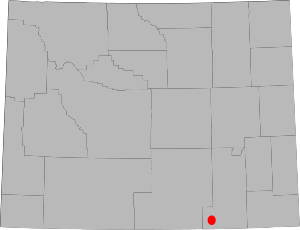Wyoming toad facts for kids
Quick facts for kids Wyoming toad |
|
|---|---|
 |
|
| Conservation status | |
| Scientific classification | |
 |
|
| Geographic distribution in Wyoming | |
| Synonyms | |
|
The Wyoming toad (Anaxyrus baxteri), also called Baxter's toad, is a very rare type of toad. Sadly, you can only find these toads living in special places where people care for them. These places are called captivity programs. For example, the Mortenson Lake National Wildlife Refuge in Wyoming helps to breed these toads.
This toad was first listed as "endangered" in 1984. This means it was in danger of disappearing forever. By 1991, it was listed as "extinct in the wild." This means there were no more Wyoming toads living freely in nature. Their numbers dropped very quickly around 1975. By 1980, they were extremely rare.
To help save them, a special program was started in 1989. This program breeds toads in captivity. In the first few years, many young toads were born. These toads were sent to seven different zoos. In 1998, the Saratoga National Fish Hatchery also started to breed these toads.
Between 1995 and 2006, nearly 46,000 young toads were produced. Many of these toads were released back into the wild. Before their numbers dropped, the Wyoming toad was thought to be a type of Canadian toad.
Life of the Wyoming Toad
In nature, female Wyoming toads lay their eggs in shallow parts of ponds and lakes. The baby toads, called tadpoles, swim in the warmest areas of the water.
Adult toads look for food during the day. They hide at night to stay safe. Sometimes, they even use burrows dug by small animals like rodents. Adult toads mostly eat ants. They also enjoy eating beetles and other animals without backbones.
Why They Became Rare
Scientists are not completely sure why the Wyoming toad started to disappear in the 1970s. They have a few ideas about what might have happened.
One idea is that people were using an insect-killing chemical called Baytex. This chemical might have harmed the toads. Another idea is that more animals like seagulls, pelicans, and raccoons started eating the toads. Also, changes to their living spaces might have played a part. For example, irrigation for growing hay might have changed the ponds and lakes where they lived.
Images for kids
-
Wyoming toad being examined by a FWS employee
See also
 In Spanish: Sapo de Wyoming para niños
In Spanish: Sapo de Wyoming para niños






